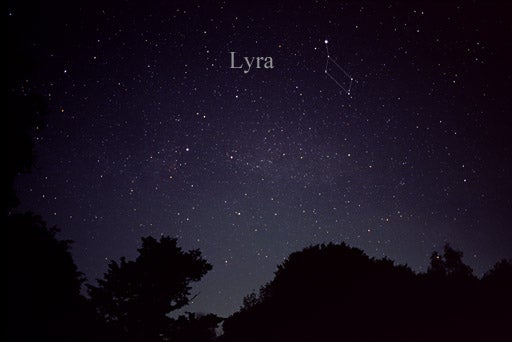
Friday, September 23
Last Quarter Moon occurs at 5:56 a.m. EDT. It rises around midnight local daylight time this morning, which gives North American observers a chance to see it almost precisely half-lit. Earth’s only natural satellite appears among the background stars of northern Orion, approximately 10° north of the red supergiant star Betelgeuse.Saturday, September 24Uranus reaches opposition three weeks from today, but it already has become a tempting evening target. The ice giant world rises before twilight ends and climbs nearly 40° above the eastern horizon by 11 p.m. local daylight time. The magnitude 5.7 planet lies in Pisces, 2.4° north-northwest of magnitude 4.8 Mu (m) Piscium. Although Uranus is bright enough to see with the naked eye under a dark sky, binoculars make the task much easier. A telescope reveals the planet’s blue-green disk, which spans 3.7″.
Sunday, September 25Saturn remains a gorgeous sight in the evening sky all week. It stands some 20° high in the southwest as twilight fades to darkness and doesn’t set until after 10 p.m. local daylight time. The ringed world resides among the background stars of southwestern Ophiuchus, just 6° north of Antares, the brightest star in neighboring Scorpius. The yellow-hued planet shines at magnitude 0.5 and appears significantly brighter than the ruddy star. When viewed through a telescope, Saturn shows a 16″-diameter disk surrounded by a dramatic ring system that spans 36″ and tilts 24° to our line of sight.Friday, September 16Full Moon occurs at 3:05 p.m. EDT, but our satellite will look completely illuminated all night. You can find it rising in the east around sunset and peaking in the south by 1 a.m. local daylight time. The Moon lies among the dim background stars of Pisces, due south of the Great Square of Pegasus. As the Full Moon closest to the autumnal equinox six days from now, this is also the Harvest Moon. In early autumn, the Full Moon rises about half an hour later each night compared with a normal lag close to 50 minutes. The added early evening illumination supposedly helps farmers bringing in their crops. The Full Moon also passes through Earth’s outer shadow today, bringing a penumbral lunar eclipse to observers across Europe, Asia, Africa, and Australia. At the peak, which occurs at 18h54m UT, 91 percent of Luna will be immersed in the shadow and viewers will see a distinct dusky shading over the Moon’s northern half.
Saturday, September 17Skywatchers with an unobstructed horizon toward the west-southwest should keep an eye out for Venus this week. Although the planet stands just 6° high 30 minutes after sunset, it shines so brilliantly (magnitude –3.9) that it stands out against the bright twilight. Target Venus through binoculars this evening and you should also spot the 1st-magnitude star Spica, which lies 3° south (lower left) of the planet.
Sunday, September 18The variable star Algol in Perseus reaches minimum brightness at 5:42 a.m. EDT. If you start watching late Saturday evening, you can see its brightness diminish by 70 percent over the course of about five hours as its magnitude drops from 2.1 to 3.4. This eclipsing binary star runs through a cycle from minimum to maximum and back every 2.87 days. Algol passes nearly overhead shortly before morning twilight commences.The Moon reaches perigee, the closest point in its orbit around Earth, at 1:00 p.m. EDT. It then lies 224,872 miles (361,896 kilometers) away from us.Monday, September 19
Once Venus sets during evening twilight, Mars becomes the brightest point of light in the sky. The Red Planet shines at magnitude –0.1 and appears about 20° high in the west-southwest in early evening. Mars lies among the background stars of southeastern Ophiuchus, but it will pass into Sagittarius in just two days. A telescope will show the planet’s 9″-diameter disk, which should show a few subtle dark markings during moments of good seeing.
Tuesday, September 20Although Mercury passed between the Sun and Earth just eight days ago, the planet named for the fleet-footed messenger god in Roman mythology lives up to its reputation this week as it climbs into view before sunrise. You can find the innermost planet 5° above the eastern horizon 30 minutes before sunup. Mercury shines at magnitude 1.7, so you’ll likely need binoculars to pull it out of the twilight glow. A telescope reveals the planet’s 9″-diameter disk, which shows a thin crescent phase. Mercury climbs higher and brightens rapidly as it heads toward greatest elongation next week, when it appears 11° high a half-hour before sunrise and shines at magnitude –0.5.Wednesday, September 21Although autumn arrives with the equinox tomorrow, the Summer Triangle remains prominent in the evening sky. Look high in the west after darkness falls and your eyes will fall on the brilliant star Vega in the constellation Lyra the Harp. At magnitude 0.0, Vega is the brightest member of the Triangle. The second-brightest star, magnitude 0.8 Altair in Aquila the Eagle, lies some 35° southeast of Vega. The asterism’s dimmest member, magnitude 1.3 Deneb in Cygnus the Swan, stands about 25° east-northeast of Vega. For observers at midnorthern latitudes, Deneb passes through the zenith at approximately 9:30 p.m. local daylight time, about an hour after twilight ends.Thursday, September 22With the days growing shorter and kids back in school, it shouldn’t be surprising that summer’s reign is just about over. The warmest season comes to an official close at 10:21 a.m. EDT, when Earth reaches the autumnal equinox. This marks the moment when the Sun crosses the celestial equator traveling south. Our star rises due east and sets due west today. If the Sun were a point of light and Earth had no atmosphere, everyone would get 12 hours of sunlight and 12 hours of darkness. But the presence of air and the finite size of our star make today a few minutes longer than 12 hours.









